Introduction to Golestan Palace
In this article we want to introduce you to Golestan Palace and all the sights and attractions of this palace.
This article is one of a series of articles on the site of the Hoteloneclick, designed to familiarize travelers with Tehran tourist attractions.
In this article we will try to explain to you all the historical attractions of Golestan Palace in Tehran, which is one of the tourist centers in Tehran, along with its details. This article is actually a tourist guide to Golestan Palace in Tehran.
In this guide you will be introduced to different sights and parts of the Golestan Palace.

- Why Golestan Palace?
- The Global Collection
- Golestan Palace Atmosphere
- A quiet spot
- The colorful world of tiles
- Having a cup of tea
- Departments and museums
- 1. Collection’s Yard
- 2. Shams Al-Emareh
- 3. Takht-e Marmar Terrace
- 4. Khalvat Karimkhani
- 5. Main Hall
- 5.1. Salam Hall
- 5.2. Ayeneh (Mirror) Hall
- 5.3. Aaj Hall
- 5.4. Container Hall
- 6. Berelian Hall
- 7. Badgir mansion
- 8. Photo Gallery
- 9 . The spring house of Salam Hall
- Negarkhaneh
- Special Museum
- 10. Museum of Anthropology - Abiaz Palace
- 11. Almas (Diamond) Hall
- Buildings that no longer exist
- 1. Tekyeh Dowlat
- 2. Khorooji mansion
- 3. Andaroon and Nasseri Dormitory
- History of Golestan Palace
- Golestan Palace architecture
- Combining Iranian and European style
- Unmatched tile work
- Eye-catching mirroring
- Gilding on stone
- Leisure and Tourism Facilities
- Teahouse
- Qajar style photography
- Other Features
- Side services
- 1. Manuscript library
- 2. Image Documentation Center
- 3. Manuscript Documentation Center
- 4. Technical office
- 5. Printed library
- 6. International Affairs
- 7. Cultural Affairs
- 8. Introduction Affair
- 9. Child and adolescent unit
- Access to Golestan Palace
- Visiting information
- Important notes
- National and World Registration
- Tourists comments
- Conclusion
Why is Tehran's Golestan Palace one of the most important historical attractions in Tehran?
We go to 15 Khordad Street to see the only globalized work of the capital which is Tehran's Golestan Palace.
We go inside this global complex and look at each of its buildings. The decorations and architecture of the Golestan Palace are so spectacular that you can't miss even the simplest things.
Stay with us to take a look at the history of the Golestan Palace and introduce you to its spectacular buildings.
Take a step inside the hotel with the Hoteloneclick to see what's going on and how it is mesmerizing the old and the young.
The reasons for choosing Tehran's Golestan Palace as one of the most important tourist attractions of Tehran are as follows:
- One of the World Heritage Sites in Iran whose name shines on the UNESCO Heritage List.
- A unique example of architecture and decoration. Tile samples of this collection cannot be found anywhere else.
- One of Tehran's most famous places for taking eye-catching photos.
- In this complex, you can take a tour of the history and enjoy its pleasant atmosphere.
- It is very easy to access by public transport.
- Located in the old texture of Tehran and takes you to the mood of the capital in years ago.
- Examples of combination of Iranian and European architecture.
- One of the popular attractions of Tehran among foreign tourists.

Introduction to the Global Collection of Golestan Palace - Iran's unmatched legacy
If you ask someone what neighborhood is in the heart of Tehran; they will tell you about the Grand Bazaar and 15 khordad street.
In recent years, officials have turned it to pavement and it is a reminder of the old Tehran. Many believe that the real Tehran is this neighborhood, a place where you can walk for hours and see many attractions.
Golestan Palace is a name that shines among Tehran's attractions and is also on the UNESCO Cultural Heritage List.
Most people consider the collection a work of the Qajar era, but its history goes back to many years ago. Golestan Palace is one of the most unique historical collections of Iran for more than 440 years and with its beauty attracts every viewer.
Nasser Najmi writes in the book "Tehran in the Nasserian Age" that it is named after the plant in the garden or in the Golestan and the existence of gardens and long streets with sycamore trees.
Of course, this is only a guess, and it is still in a state of uncertainty. Some attribute this collection to the Golestan Hall in one of the ruined mansions of the garden today, the mansion called the Khorooji Mansion, which we will discuss later.
The Golestan complex has hosted kings for many years like Aqa Mohammad Khan Qajar, Fath Ali Shah, Mohammad Shah Qajar, Nasser Al-Din Shah Qajar, Mozaffar Al-Din Qajar, Mohammad Ali Shah Qajar, and Ahmad Shah Qajar.
Today the Golestan Palace with 5.4 hectares is only a tenth of its original extent. Of all the glory, there are only a few buildings left and is missing in the new constructions.
The complex has numerous buildings that examining each one of them take you to a new world. This is just a brief introduction to each of these works to find out what is expecting you in the collection.
Later you will read a detailed description of each of the buildings in this collection in separate sections.
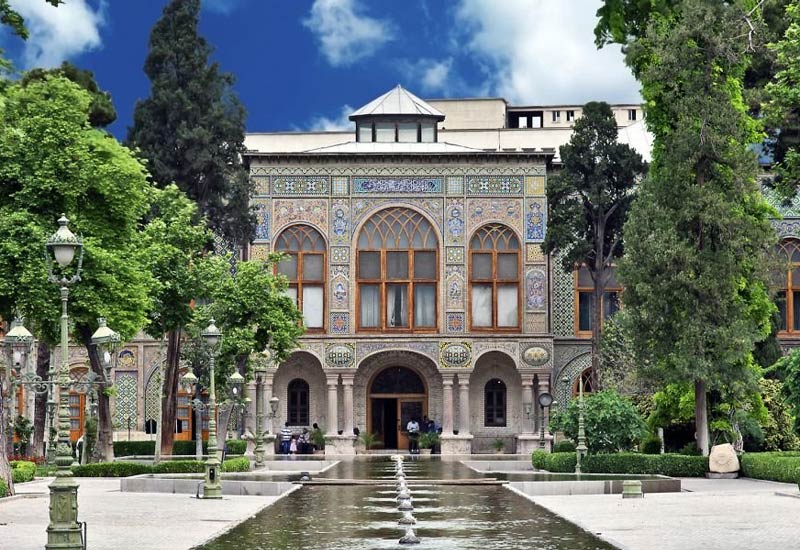
Tehran Golestan Palace is one of the most important historical sites in Tehran. If you have not yet traveled to Tehran, you can select the best Tehran hotels by booking Tehran hotels.
The great atmosphere of Golestan Collection
The Golestan Palace complex may carry the title of a monument and have a lot to say about the history of the land, but not all its attractions end here.
A quiet spot away from the noise
Imagine the buzz of 15 Khordad street, the peddler market is hot and the shopping carts are heading around. The carriages move people and the sound of their movement on the cobblestones is constantly heard.
Walk a short distance from this street to the Golestan Collection; no more buzzing. Now everything is the sound of a waterfall and the cool breeze and the sound of birds.
As if time is back and the inhabitants of this palace are still alive, life is still flowing, and the Qajars are on there. You can choose a cozy corner, close your eyes and go to another world.
The colorful world of tiles
If you know just a little about the colors and design you will be so delighted here. There is a world of motifs and images in front of you, and you can see the most spectacular Iranian tiling in there.
They are so delicate motifs that you think they will break down. Now imagine many years ago with the facilities of that time such masterpieces have been created.
Having a cup of tea
There is also a small café and teahouse in the complex, where you can enjoy sweet and pleasant moments.
Sit on a chair in a Qajar mansion with European- Iranian style architecture for a drink or a delicious Iranian snack or a delicious snack.
In short, the courtyard of the Golestan Palace invites you to a different journey, where a touch of history will be more enjoyable than anywhere else, where it will take you from all your worries and bring you peace in the midst of the hustle and bustle of the city.
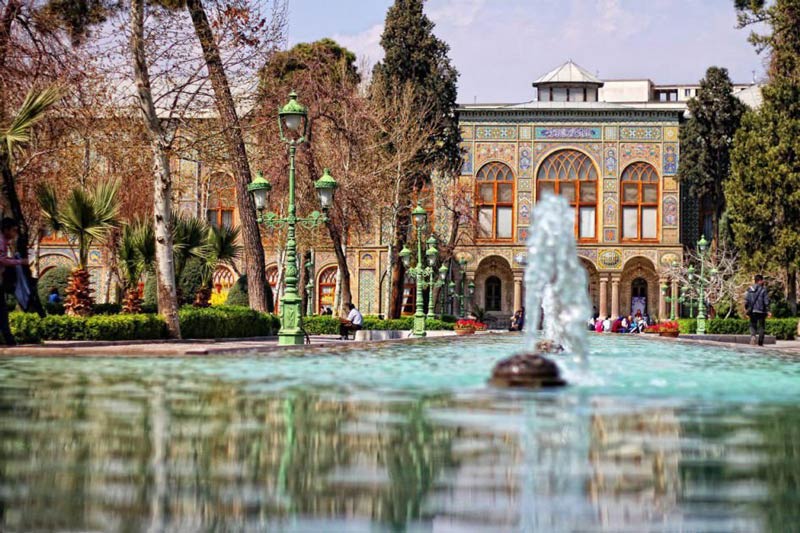
Departments and museums of Golestan Palace Complex
Although the size of the Golestan complex has been reduced today due to urban construction and the demolition of various buildings, you can still see numerous buildings that are interesting museums.
Stay tuned to discuss different parts of this complex. Of course, this is just a brief overview of each of these buildings, and you'll read a detailed description of them later:
1. Collection’s Yard
In Golestan, the buildings aren't the only attractions for spectators in the complex; the yard with towering trees and pools and fountains gives you a different mood.
Where photography subjects are abundant for art lovers.
From colorful tiles dancing of water in the pool and to each of the can draw your attention.
It is best not to go straight to the buildings and go around the yard.
There is also a small market near the entrance that takes you into the colorful world of crafts and you can buy good memories from there.
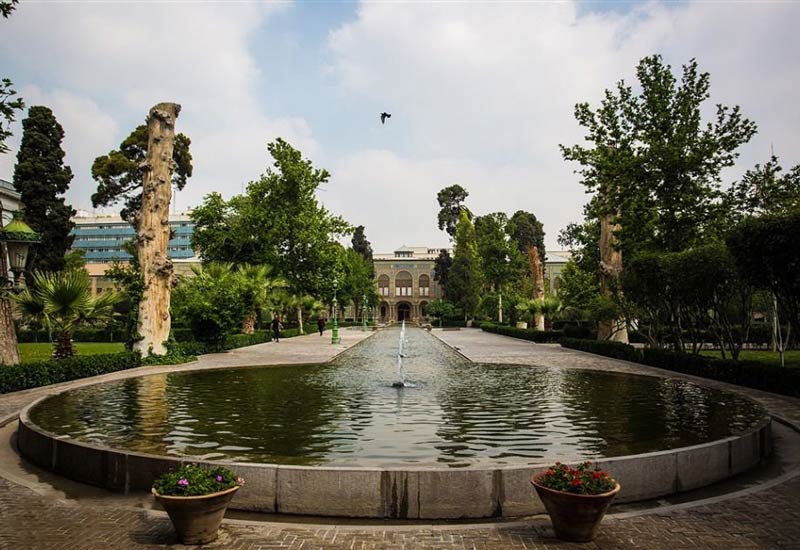
2. Shams Al-Emareh: Ancient symbol of Tehran
It's up to you what building to see first and which buildings to turn to next.
There is no pre-arranged direction in the Golestan Palace, but we first invite you to visit the flagship of the complex, a building that used to be the capital's symbol before the National Garden was built.
It is also known as one of the symbols of ancient Tehran.
It is a tall and interesting building that is one of the most prominent buildings of the Golestan Palace and the most prominent one in the eastern side of the complex.
The building comes from the Nassereddin Shah’s travels to other countries.
He had been fascinated by the Western skyscrapers before heading to Europe. He longed for a tall building like them in the capital.
He dreamed of having a building that he and his wives could view over the cityscape of Tehran and the surrounding landscape.
This dream, which may make you laugh now, was one of the symbolic structures of ancient Tehran.
The building was completed in 1832 and was remarkable in terms of height, decoration and design and was the tallest building in Tehran on 5 meters and 35 meters high.
Shams Al-Emareh was the first building that used metal in its construction, and it was also a change in construction.
The cost of constructing this building, along with providing the equipment, reached forty thousand Tomans.
One cannot deny the beauties of the facade of the building, but its interior design is unique as well.
Mirrors and paintings and plaster have made this building a magnificent work that mesmerize everyone.
3. Takht-e Marmar Terrace (Marble Throne Verandah)
Now it comes to the oldest building in the complex called Takht-e Marmar terrace, the Darolemareh or Divankhaneh porch and its construction dates back to the time of Karim Khan Zand.
During the Qajar era, it was a place for kings to come and congratulate the people on various occasions.
This terrace is the representation of plaster work, masonry, inlay, mirror and looks very eye-catching.
What makes this porch more interesting is the presence of a marble bed built by the order of Fath-Ali Shah in 1806.
He ordered Isfahani masters of masory to make a bed of yellow marble of Yazd and install it on the porch.
65 pieces of large and small marble were used in this bed, designed by Mirzababa Shirazi Naghashbashi, and the masory was done by the master Mohammad Ebrahim Isfahani.
The throne was designed to resemble the throne of Prophet Solomon on the shoulders of evils and Fairies.
The work is surrounded by 3 demons and 6 angels or humans on each side and is about one-meter-high from the porch.
The dragon and the two lions are also other carvings of this throne, and there are verses of Malekolshoara on the praise of Fath Ali Shah and the description of the marble throne.
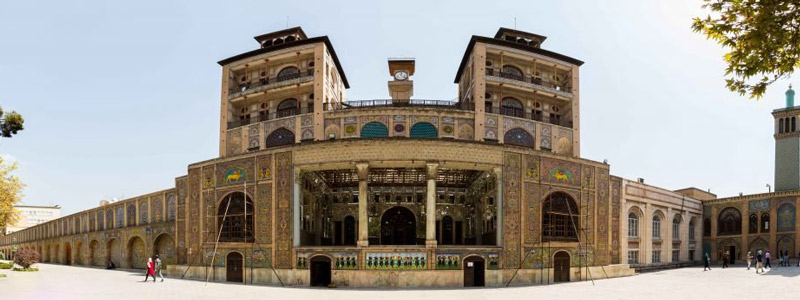
Golestan Palace in Tehran is one of the historical sites close to Espinas Persian Gulf Hotel in Tehran. If you have not yet booked your hotel, you can use the link below to book Espinas Persian Gulf Hotel in Tehran.
4. Khalvat Karimkhani (Karimkhani Nook)
In the northwest corner of Golestan, there is a covered building like a three-lane porch that draws attention with its raised columns.
Its name is Jolo Khan or Khalvat Karimkhani and it has a special beauty.
In the middle of this section there is a pond which Shah's aqueduct used to flow out of it and flow into the royal gardens.
It is of great importance in two respects: one is the date of it that goes back to the time of Karim Khan and the other due to the cruel behavior of Aqha Mohammad Khan Qajar with the rotten bones of Karim Khan Zand.
The founder of the Qajar dynasty in 1791 removed the remains of Karim Khan Zand's corpse from the heart of Shiraz and transferred it to Tehran.
He buried these bones beneath the stairs of Khalvat Karimkhani.
Here at that time was the king's daily passing way, and he was very happy putting his feet on it.
Nasser Al-Din Shah turned the place into a small courtyard called the Karimkhani courtyard, where he would rest and smoke shisha in this cozy corner.
As soon as Pahlavi came to power (February 1925) he ordered to break the stairs and find the bones of the Karim Khan and move them to a suitable place.
The workers later found the bones and transported them to Qom.
What is of paramount importance to Khalvat Karimkhani today is the existence of two valuable works:
- The tombstone of Nassereddin Shah, that was located in the Abdol Azim tomb, then was transferred to the Golestan Palace at the beginning of the Islamic Revolution and was installed in Khalvat Karim Khani after 17 years. The stone is 249 x 131 cm, and has the natural image of Nasser Al-Din Shah with a sword in his hand.
- Fath Ali Shah's throne, made of marble and according to historical documents, was in another part of the palace during the Qajar period and was moved to this place during the second Pahlavi period. Poems about the throne confirm its belonging to the time of Fath Ali Shah.
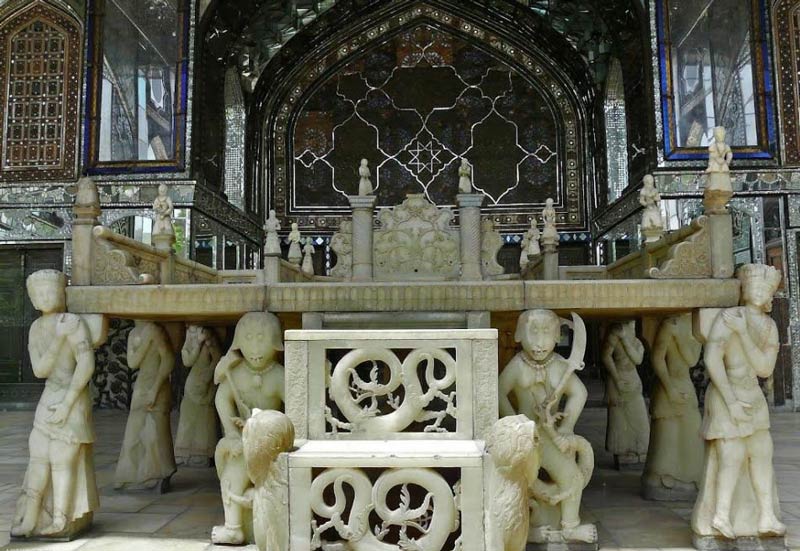
5. Main Hall
One of the areas that amazes you is the part known as the Main Hall, which has the following sections:
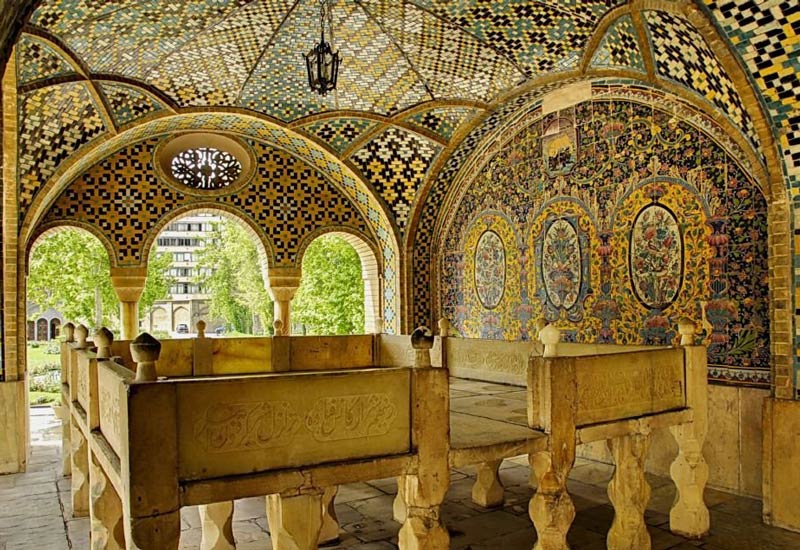
5.1. Salam Hall
On the northwest side of Golestan Garden and just over Khalvat Karimkhani we reach a building that was originally designed to be a museum and was called the Museum Room.
Of course, the first royal and state museum of Iran was founded by Nasser Al-Din Shah in a building between Shams al-Emareh and the northeast corner of the garden, but when the saw large Western museums and galleries, he wanted museums like them to be boastful of.
His desire led to the demolition of old mansions on the north side of the Golestan Garden, creating a museum room, a hall, a basin room, etc. instead, that can still be seen in the complex.
The construction of the Museum Hall and other parts of the building was completed in 1876 AH, but it was not until 1879 AH that the decoration of the Hall and the arrangement of objects and works and the installation of boards and etc. were completed.
Nasser al-Din Shah is said to have been involved in arranging the museum and locating objects and artifacts and jewelry, and has repeatedly commented on the arrangement of the hall.
It is said that one of his hobbies was the design of the museum, especially its jewelry.
The museum room was later renamed Salam Hall and also Tajgozari (coronation) hall to be named after the Pahlavi Coronation Hall.

5.2. Ayeneh (Mirror) Hall
In the west of the Salam Hall and attached to it is one of the famous Halls of the Golestan Collection called Hall of Mirrors, which was built at the same time as the Hall of Salam as a part of the museum building.
Initially, this section was dedicated to the Takht Tavoos (peacock bed) and Crown of Kiani, but today the fame of the hall is due to the late Mirza Muhammad Khan Kamal al-Molk Ghaffari's oil paintings, which displays the hall in 1891 in its utmost glory.
Construction of this hall was completed around 1877, but its decorations and mirrors and plasterwork continued until 1882.
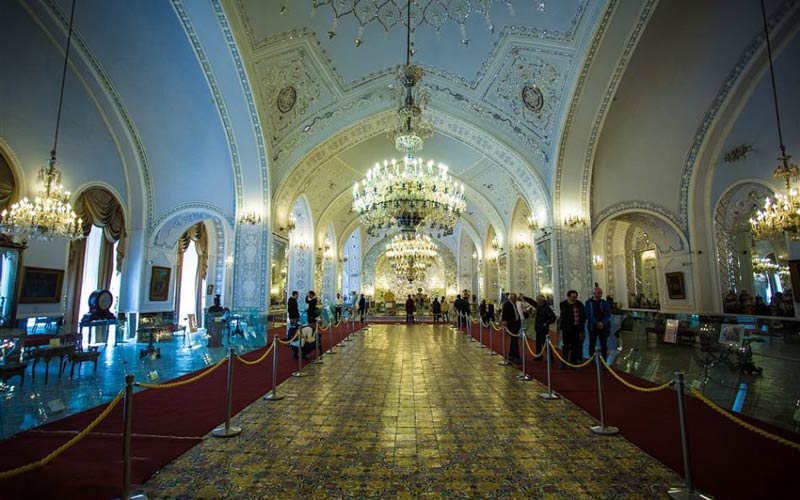
5.3. Aaj Hall
Slightly beyond the Mirror hall we see this hall.
The date of construction of this hall and the spring house in the basement is not known, but evidence suggests that it was built before the Halls of Mirror and Salam.
The watercolor painting of Mahmoud Khan Malek al-Shoa'ra shows its facade in 1869 AH.
From the picture it can be seen that the building has three verandas, three large windows and a porch with six elegant columns and a staircase to the west.

5.4. Container Hall
The Hall of Containers is a section built in 1965 on the remnants of the Qajar empire, in which some of the European kings' gifts to the Qajar kings are displayed.
Among the dishes in this forum are:
- Chinaware related to the Wars of Napoleon Bonaparte
- Russian Emperor Nikolai I's gift
- Queen Victoria's jewelry dishes gift
- A service made of precious Malachite stones donated by Alexander III
- Chinaware given by Wilhelm to the Prince of Iran Government
Golestan Palace is one of the historical places in Tehran. Parsian Azadi Hotel is one of the best hotels in Tehran. If you haven't booked your hotel yet, you can use the opposite link to book Azadi hotel in Tehran
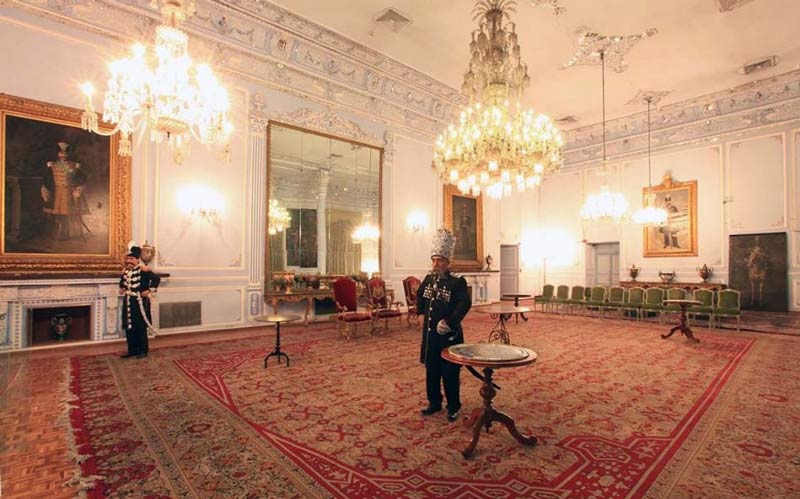
6. Berelian Hall
In the east of the Aaj Hall, there are several beautiful halls and rooms with plenty of mirrors, chalets, and staircases and numerous halls.
This part is known as the Berelian Hall and is located just in a lower height the Aaj Hall.
Before the Berelian Hall was formed here, the Palace or Bolour Hall was at this point considered one of the monuments of Fath-Ali Shah.
During the reign of Nasser al-Din Shah, this hall was destroyed, and the Berelian Hall was replaced.
The floor of this hall was built on the foundations of the same Hall of Kiristal, so they were unable to align the floor with the other ones.
The hall was refurbished during the reign of Mozaffar al-Din Shah and added to its splendor. Oil paintings from the Berelian Hall are available prior to the repairs and alterations of Mozaffar al-Din Shah, which you can see in the Hall of Salam.
During the reign of Nasser al-Din Shah, this hall was a place where the gifts of kings of foreign governments were kept, and during Pahlavi's time it became a place of reception and a formal party for the court.
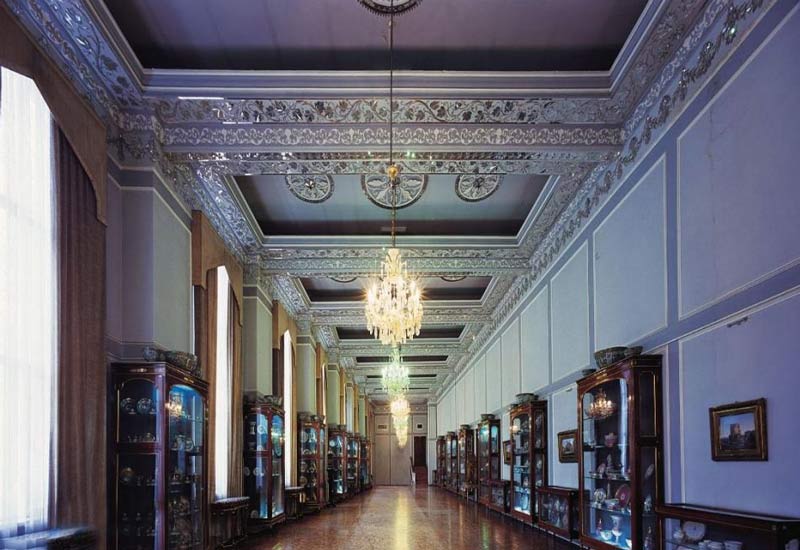
Parsian Esteghlal Hotel in Tehran is one of the best hotels in Tehran. If you haven't booked your hotel yet, you can use the opposite link to book Esteghlal hotel in Tehran.
7. Badgir (wind catcher) mansion
It is one of the buildings on the south side of the Golestan Garden. It was built in the time of Fath Ali Shah, but in the time of Nasser Al-Din Shah major changes were made to it and it has become what it looks like today.
Elegant earrings and mansions and atriums are part of the building, and the sashes and pillars have given them a special beauty.
Painting, mirrors, plastering, carving and marble have been used throughout the mansion, making it one of the most interesting and prolific buildings of the royal citadel at the time.
The King's Hall is a unique masterpiece, and these decorations are used: nine sashes, two plaster labyrinth columns of Zandieh-style, painted marble floors, a seven-color mosaic floor and mirror work and wall and ceiling paintings.
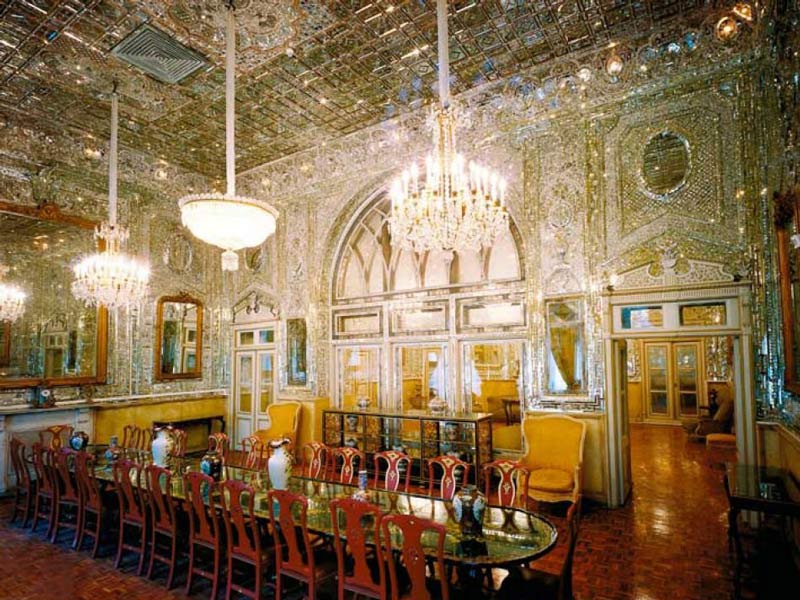
8. Photo Gallery (Spring house)
Underneath the wind catcher, there is a spring house with four long wind catchers on the corners with blue, yellow, and black tiles.
The air in the spring house and the hall and the rooms is cooled by the same wind catchers.
In the middle of this space is a pond where water would flow to that in the past, but nowadays they have blocked the way of water to prevent damage to the building.
Now the spring house hosts a photo museum where you can see a collection of Qajar period photographs and photography supplies of that time.
You will find photos in this collection bearing the handwriting of Nasser Al-Din Shah. The king was very fond of photography, so he took many pictures.
The photo collection of this section of the Golestan Palace is the second largest after the British Royal Collection.
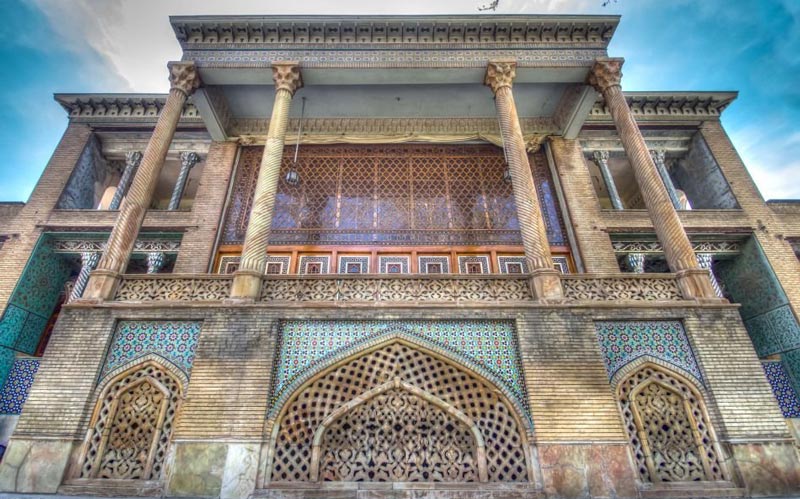
9 . The spring house of Salam Hall
In the spring house of Salam Hall, you can see two sets of objects:
Negarkhaneh
Negarkhaneh is the name of a museum in the Golestan complex that can be found in a part of the courtyard or lower floor of the museum room, the Hall of corronation, or salam.
The story of the creation of the spring house and its modern form dates back to the first trip of Nasser Al-Din Shah Qajar to Europe in 1873.
Visiting those countries, he determined to change the royal citadel. His dream came true with the completion of architectural operations such as the Hall of Salam, the Hall of Mirrors and the spring house.
The Negarkhaneh Museum has two sections:
- The southern part which was one of the museum's spring house had many uses over the years: museum hall warehouse, an exhibit, a property office and a telephone shop.
Nowadays, this section is dedicated to displaying paintings such as works by Mirza Baba Naghashbashi Shirazi, Mehr Ali, Ahmad, Ismail Jalayerr, Ali Akbar Khan Mozayan Al-Dowleh, Abolhassan Sani, and others, all of which belong to the pre-Qajar era. - The northern part, built during the Second Pahlavi era as the headquarters of the royal guard and nowadays contains paintings by late Qajar painters, some of whose artists are: Mahmoud Khan Saba, Mohammad Ghafari Kashani (Kamal al-Molk), Mirza Mehdi Khan (Mosavar Al-Molk), Mr Mirza Musa and etc.
The collections of these two parts were linked together in late 1995 and after restoration in May 1997, it was reopened as a gallery.
Special Museum
A section of the spring house of Salam Hall also is dedicated to Special museum.
This part of the Pahlavi era was adorned with plaster ornaments and has since been named the special museum.
In this museum you can see the most exquisite artifacts left by the Qajar kings; some of them were part of a collection that was once housed in the Nassereddin Shah Museum Room.
These objects have either been acquired by the Qajars from earlier periods or have been dedicated to them by kings and artists of their time, and some have been purchased by themselves or their associates.

Golestan Palace in Tehran is one of the historical sites of Tehran. If you have not yet booked your hotel in Tehran, you can use the link below to book Tehran Espinas Palace hotel.
10. Museum of Anthropology - Abiaz Palace
It was during the reign of Nasser Al-Din Shah that King Sultan Abdul Hamid, the Ottoman king, sent some expensive furnishings to the king of Iran, among which were: some hand-made Louis XVI sofas, velvet curtains, two pieces of mirror with frames, bronze sculptures and beautiful material and a few pieces of Turkish carpet.
At that time, all the palaces were at the height of their beauty and none of them had room for new stuff.
It was an excuse for the Shah to build a new palace in the southwest corner of Golestan.
It is said that Nasser Al-Din Shah made the map of the new palace and determined the size of the large hall according to the width and length of the king's largest rug.
When the palace was finished, Nasser al-Din Shah, who was fascinated by European architecture, painted it white and even used white marble stairs. It was an excuse to name the rebuilt palace Abiaz (white).

By placing the stuff, a magnificent and well-appointed hall was created and was called the Abdol Hamid Hall.
The palace became the working place of the Chancellors, the Chiefs of Governments, and the Prime Ministers of the later governments, and in 1953 it was devoted to the fine arts of the country.
The building became the site of temporary exhibitions and the center of General activities of the Museums and in 1968 became the Anthropology Museum.
The Museum of Anthropology is one of the oldest and richest anthropology museums in the country, where you can see the Qajar men's and women's clothing in addition to the clothing of various regions of Iran.
11. Almas (Diamond) Hall
In the southern part of the Golestan garden area, and after the wind catcher mansion, there is one of the oldest parts of the royal citadel known as the Diamond Hall.
The foundation dates back to the time of Fath Ali Shah, but Nasser Al-Din Shah has also changed its appearance and decorations.
The interior mirrors of the building have given it the name Diamond.
The oldest work in this room is the mirrored Mogharnas, located on the south porch of the hall.

Buildings that no longer exist
In addition to the buildings being visited today, it also houses buildings that are no longer visible. Some of the most important of these are:
1. Tekyeh Dowlat
Around 1867, under the orders of Nasser Al-Din Shah and his companion, Doost Ali Khan Moir Al-Mamalek (the mint supervisor), spent over 300,000 tomans over a five-year period to build a building called Tekyeh Dowlat.
At the time of its construction, Tehran had about 50 Tekyehs, but the architecture of this one distinguished it from its counterparts.
In the book of History of the Golestan Palace and Royal Buildings, Yahya Zoka explains the reasons for the establishment of Tekyeh Dowlat:
Tehran's most prestigious and widely held Ta’ziyeh were in "Haj Mirza Aghasi" Tekyeh, also called "Abbas Abad".
The strong welcoming of people, especially women, for religious performances, as well as the smallness of Abbas Abad's atmosphere, inevitably produced excess crowds, disrupting the work of imitation and demanding greater and wider place.
Hence, Nasser al-Din Shah, while giving orders to begin the construction of Shams Al-Emareh, also issued a decree to Dost Ali Khan Moir al-Mamalek to establish a great reliance on the royal citadel.
It was built on the southeast side of Golestan Garden and on the southwest side of Shams Al-Emareh. Of course, about the precise position of Tekyeh Dowlat, there is still no consensus, and there are slight differences between experts' claims.
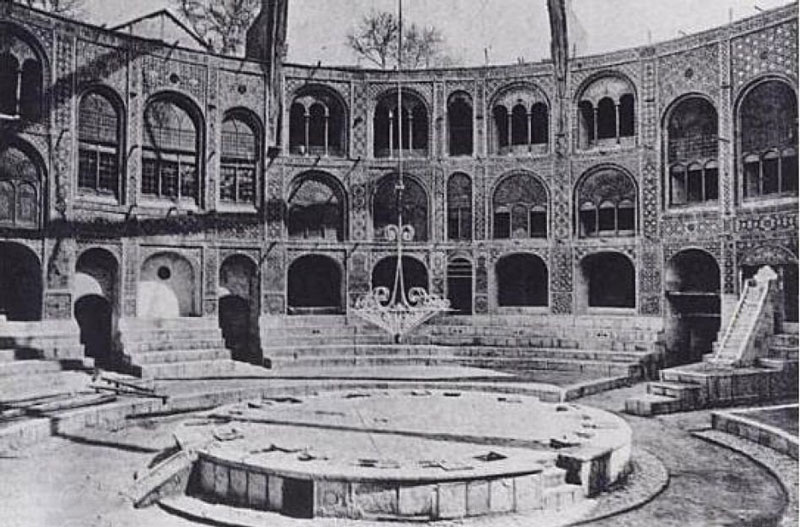
Some foreign scholars have considered Tekyeh Dowlat architecture to be derived from Western theaters and amphitheaters.
This is, of course, a matter of ambiguity, as Nasser Al-Din Shah's first visit to Europe was in 1873 but it was built in 1867-1873.
Other scholars see the building as the design of the fields and some inns and tavernas.
The outline of the Tekyeh Dowlat structure was similar to that of an octagonal prism, and looked like a complete cylinder with a median diameter of about 60 m from inside.
The height of about 24 meters and an approximate area of 2824 square meters and a capacity of about 20 thousand people are other features of this building. The foundation was loose and had a problem from the start.
visitors could enter from three doors:
- Large main entrance on east side for men, with double-sided door
- Western side entrance for women, from Arg Square with six small minarets on both sides
- King's Entrance, which was a dark aisle, connecting the royal section with the south side of Golestan Palace.
After the constitution, the Tekyeh Dowlat lost its value due to the influence of Western art and culture on the country and the emergence of new plays in Iran.
Occasionally, there were ceremonies other than the performing of the Ta'zieh, including the holding of a "patriotic exhibition" and the formation of a "Constituent Assembly."
Tekyeh Dowlat was Iran's largest exhibition, which was demolished after years of being abandoned and in 1946 it was destroyed to build a National Bank branch in the bazaar instead.
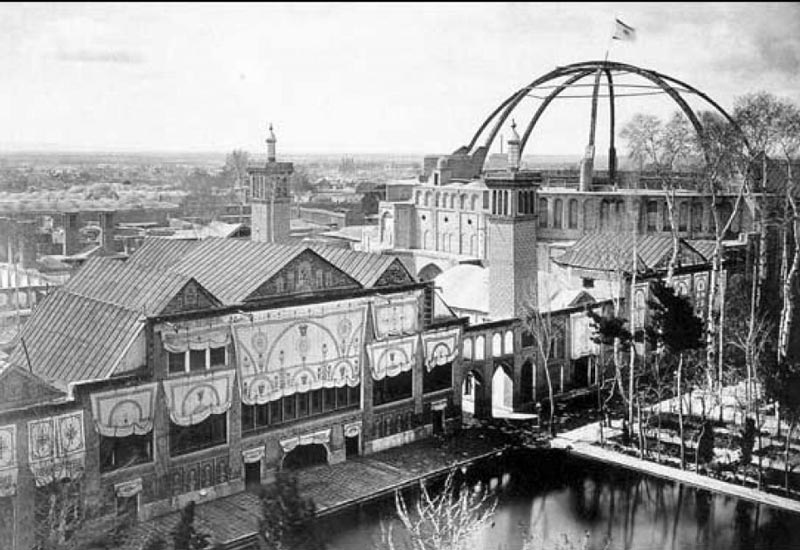
2. Khorooji mansion
In the past, there was a large mansion on the north side of Shams Al-Emareh, which divided the Golestan Garden into two parts and was known as the Khorooji Mansion.
Construction began on the time of Agha Mohammad Khan and was completed in Fath Ali Shah era. From east to west, the palace had such areas as: museum room, mirror Hall of Golestan, a Sandogh Khaneh and a Rakht Dar house.
After returning from one of his trips to Europe Nasser al-Din Shah decided to destroy it in 1879.
The site was transformed into a large pool that connected the front pool of the Wind Catcher Mansion and the Shams Al-Emareh pool and the front pool of the new Mirror Hall.
The pool, of course, did not last long, and during the early Pahlavi dynasty it was filled and changed into green space.
Some believe that the name of the Golestan palace also comes from the name of the room or the Hall of the Golestan Fath Ali Shah in the Khorooji Mansion and the whole complex became known as this name.
3. Andaroon and Nasseri Dormitory
There were several narrow gates and corridors to the north of the Golestan complex, linking it to the shrine which was also known as Andaroon and Farahabad.
Before the reign of Nasser al-Din Shah, the interior of the mansion contained buildings, rooms, and halls of the Fath-Ali era and, despite its small size, had a beautiful appearance.
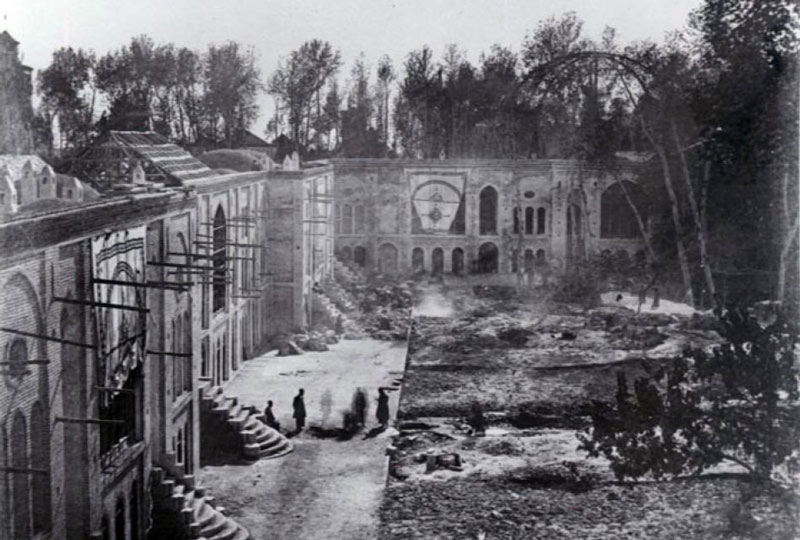
Nasser al-Din Shah made many changes to the collection during his early reign.
His shrine women were getting bigger day by day, and because of the lack of space he ordered to expand inside.
In 1299 AH all the buildings were demolished and a new building was erected.
In 1303 AH, Nasser al-Din himself requested the construction of a palace in this area.
His favorite monument was built in European style by the palace of the Ottoman Sultanate of Dolma and was named after the Nasserian dormitory.
Andaroon's mansion and its belongings were demolished during the First Pahlavi era because the king regarded it as a sign of the kings' lust, and replaced the Ministry of Finance's buildings.
Inside the Golestan Palace there was a large rectangular courtyard with two floors on each side of the building.
There were several smaller courtyards around the main courtyard, each belonging to one of the king's women.
The 7 or 8-meter-long wall separated the small courtyards from the outside of the palace.
The Nasserian dormitory was a square building that stood out in the middle of the courtyard.
The palace had beautiful rooms, halls, and stairs, with beautiful murals and eye-catching drawings on its walls and inscriptions.
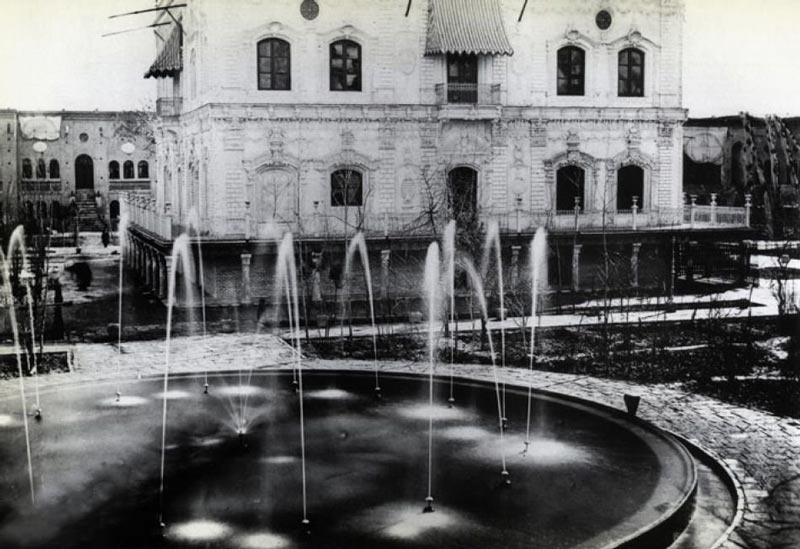
You can stay at the Ibis Hotel Tehran for accommodation in Tehran as well as visiting the Golestan Palace. If you have not yet booked your hotel, you can use the opposite link to book Ibis Tehran hotel.
History of Golestan Palace
Historical documents and evidence indicate that the Golestan Palace dates back to 1580 AH and the time of Shah Abbas Safavid.
Italian traveler Pietro Della Valle, in a part of his voyage in 1619, describes the city of Tehran with the plane trees that surrounds the royal palace and considers it the beginning of the royal citadel.
This description indicates that the collection has been taken into consideration in subsequent years.
Evidence suggests that during the time of Karim Khan Zand and between 1759 and 1776, the construction of the Divankhaneh made a series of dramatic changes, but none of the changes in the Golestan complex can be more effective and magnificent than the era of Agha Mohammad Khan Qajar.
Agha Mohammad Khan used the internal crisis of Iran in the late Zandiyeh period and after Karim Khan's death in 1779 became the ruler of the kingdom after defeating Lotfali Khan Zand. He had his coronation ceremony in Norouz 1795 and sat on the seat of power.
With the election of Tehran as the capital, the Golestan complex, which was the royal citadel of those days, gained much importance.
With the coronation of Fath-Ali Shah Qajar in 1797, everything got a different color.
On September 22nd, 1812 Nasser al-Din Shah Qajar sat on the royal throne in the same palace.
He was king of Iran until May 12, 1858 and visited Europe as the first king of Iran and had three trips to this continent.
His visit to the foreign countries caused major changes to the Golestan Palace and has been effected by the European architecture.

Mozaffar Al-Din Shah, Muhammad Ali Shah, and Ahmad Shah Qajar also became kings one by one, but until the extinction of the dynasty in 1925 the royal citadel did not change.
What increased the importance of this collection was its being associated with political events such as the Constitutional Revolution and its consequences, and thus made it an important part of the historical memory of the Iranian nation.
The coronation of the first Pahlavi on May 4th,1926 and the second Pahlavi coronation took place on November 4th, 1967.
They also made changes to the royal citadel which, according to many experts, were not as well thought out and in some cases even inappropriate.
Now Golestan Palace with a history of over 440 years is available so that you will not miss sight of one of Iran's most unique historical collections.
Today you have a collection that contains an important part of Iranian art history and is considered a valuable and living document of the most important part of Iranian history because of its important events.
Golestan Palace architecture
Golestan is in fact a historical complex comprising several royal palaces and halls all housed in a garden.
This complex reminds us of a set of interesting architectural points:
Combining Iranian and European style
Experts know the importance of the building in two ways:
- This collection represents the period of evolution of Iranian architecture and its transition. During this period, Iranian architecture was influenced by political, commercial and cultural interactions with European countries and exemplified European neoclassical architecture.
The influence that changed everything from its architecture and its associated elements to the most private aspects such as the women covering and so on. The result was a new style known as the Tehran School of Architecture. - Golestan Palace cannot be considered merely an architectural structure. This collection is a valuable treasure trove of Iranian and world monuments, which sets it apart from its Iranian counterparts in the UNESCO World Heritage List. Prior to the recording of this palace, Sheikh Safieddin Ardebili was the only monument that contained some exquisite historical objects.

Now we will talk about the architecture of this collection, which is very interesting. The architecture of Golestan Palace is professional and striking, with European styles, designs and paintings and its integration with Iranian art stuns the eyes of every viewer.
Designed and built in the Qajar era, it was both used for governing and the royal residence as well as for local artists and architects.
This collection can be considered as a place for the production of art in the 19th century and it is considered the most important Qajar art center.
The art of architecture and the art of Qajar's unique decoration, especially in the era of Nasser Al-Din Shah, can be seen in this collection.
Golestan illustrates the Iranian being influenced by European art and tells the story of the integration of both styles by Iranians.
Iranian artists have been able to take a big step toward modernity and create such a masterpiece, a work that was one of Nasser al-Din Shah's wishes and that he was left unfulfilled with his assassination.
Unmatched tile work
Tiling is one of the most eye-catching arts in our country, one of the best examples of which can be found at Golestan Palace. At Golestan Palace you can see decorations, among which tile has a considerable share.
The tiles in this collection have a variety of themes including: mythology, hunting and hunting place, war and battle, banquet, romance, landscapes and monuments, plants and animals, kings, courtiers and government agents, religion and etc.
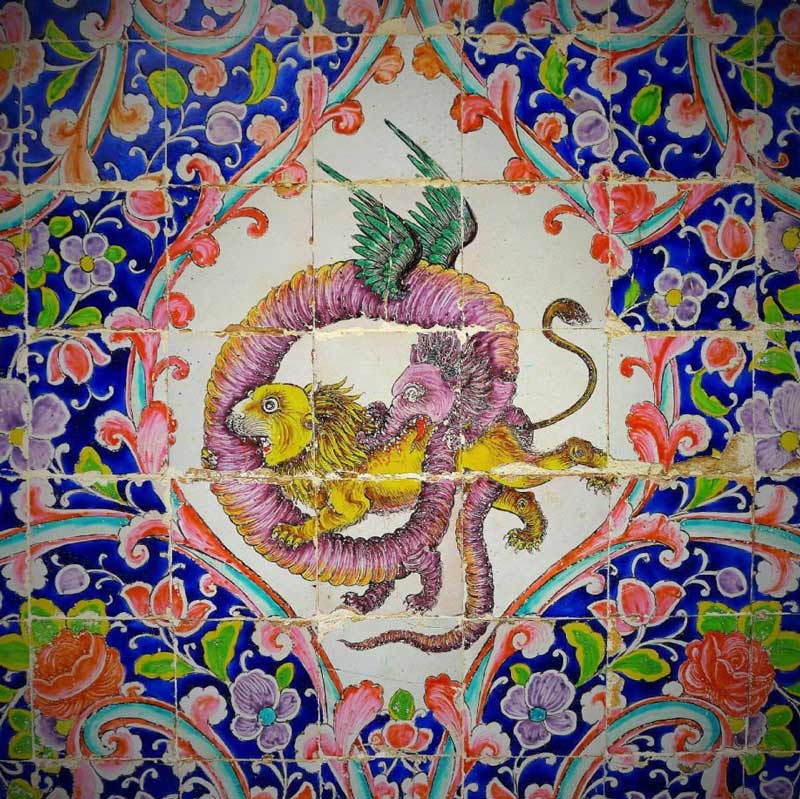
One of the features of these tiles is the influence of various factors in them, the most important of which was the expansion of the relationship with the Western world and westernization of art supporters at that time.
The impact of this can be seen in the themes and even in the way tiles are implemented and designs formed. In general, the most influential items in this tile collection can be described as follows:
- Being influenced by and modeling imported Western works and images
- Imitation of the work of Iranian painters working on the principles of Western painting.
- Tendency to literary themes
- The impact of the stone printing industry
- Influence of photography techniques
The Qajar kings, especially Nasser al-Din Shah, with their personal tastes, led the world of illustration at a time in the way that Iranian painting gradually shifted away from its traditional forms and there were significant changes in Iranian art.
During this period, the role of the views and artistic activities of individuals such as Forsat Al-Dowleh Shirazi, Kamal al-Molk, Sanaye Al-Molk, etc. should be noted.
Their works were a model for other artists and led them to become more westernized. The design of the tiles in this collection can be seen to be influenced by European painters, especially the works of Renaissance and Baroque painters.
The influence of Western practices has created a kind of duality in the collection's tiling. The use of western painting techniques such as light shading, and naturalism along with traditional Iranian painting styles show a heterogeneity.
The principles of Western painting have been used incompletely and irregularly, indicating that the painter either did not understand or did not know them well.
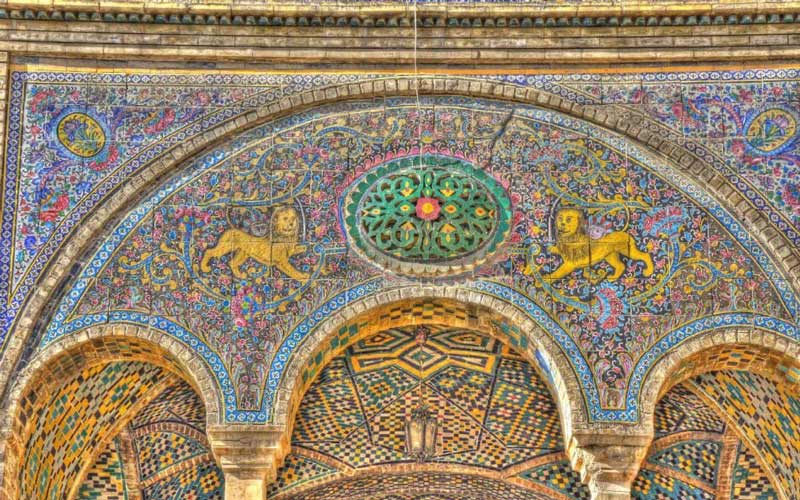
The advent of new achievements of Western civilization, including the stone printing industry and the photography industry, were not ineffective in the formation of tile motifs.
A number of illustrators of stone print books were involved in the design of the collection, and a personal signature by the name of Mustafa, a prominent figure in the field, appeared in the tiles. The images of the stone prints in this period have served as a model for the tile workers.
On the other hand, Nasser Al-Din Shah's interest in photography of other people, places and subjects has also influenced these motifs.
A significant number of the tiles are images of historic buildings and sites in Iran; photographs taken by Nasser al-Din Shah on his travels or sent to him by the rulers.
Another group of tile carvings has similar designs to antiquities that show a sense of nationalism. The most interesting of these are the engravings on coins of ancient Iran.
The postcards, photos and European paintings also had lots of impact. The motifs of Western mansions, buildings and landscapes are derived from them.
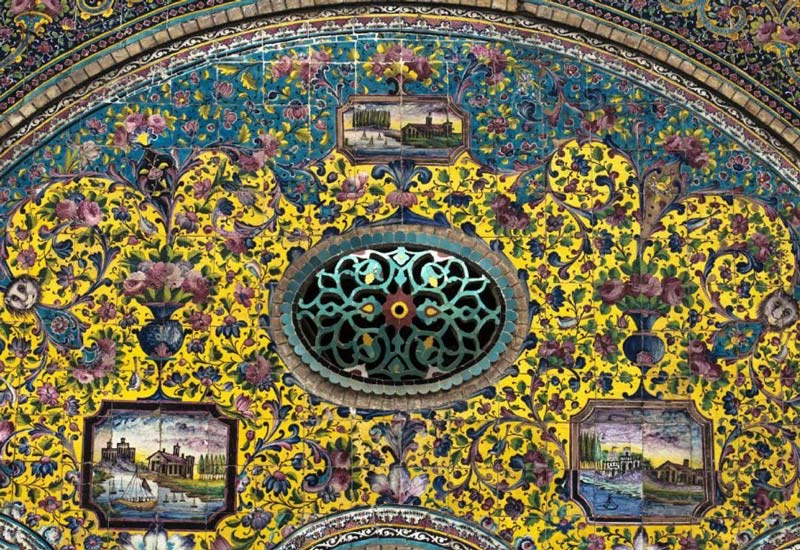
The variety of designs, themes, and even ways of doing things have made the tile work of early Safavid era in the decoration of this place not be seen.
Most of the colors used in the tiles in this collection are from warm colors. This case and the shifting roles towards naturalism and realism have given rise to the motifs of the tile workings of the Earth's space, while the art of earlier periods such as the Safavid evokes the spiritual world and the ideal spaces.
Here, too, are signs of intangible and idealistic spaces, such as the ideal figures of human that are seen in some places.
Generally, one can scrutinize these tiles and talk about them for hours, but what is important is the unmatched display of tile art in this place that gives opportunity to art lovers to visit them.
Eye-catching mirroring
Mirroring, an Iranian art and invention of the artists of this land, is a kind of interior decoration of the building that is done by gluing small pieces of mirror.
The geometric shapes, flowers and beetles are the result of this artifact and give the building a different look.
If you are fascinated by the exterior of the Golestan Collection Colored Tiles, you will be mesmerized by the magnificent mirrors inside it.
The art of mirroring in the Golestan Collection can keeps you for hours. The flagship of the art is the Hall of Mirror, which has been spent more than 7 years decorating it.
The reflection of the light in the many mirrors creates a special glow and of course a very nice coating for decoration in terms of strength and durability.
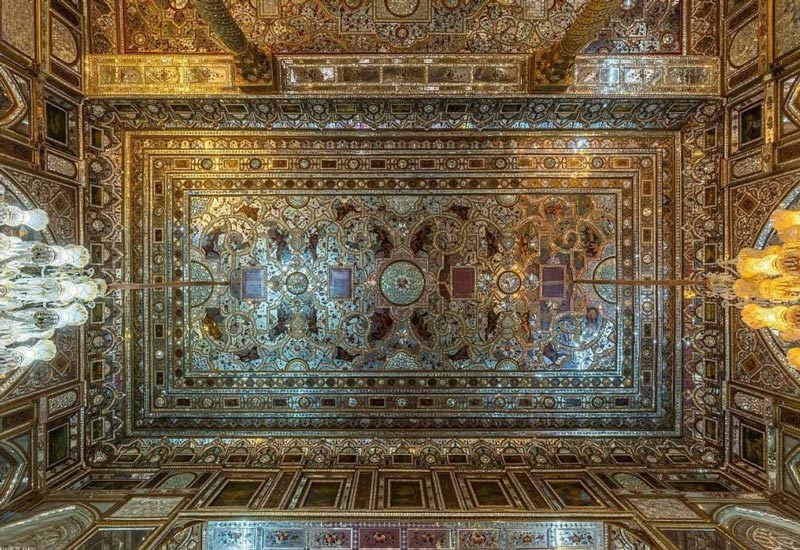
Gilding on stone
Gilded stone ornamentation is one of the most common Qajar decorations, and Shams Al-Emareh and the marble bed have this beautiful ornament.
Such decorations in the Golestan complex have different layers, including: stone support, adhesive interface, gold sheet, protective layer.
Gold ornaments with thicknesses of 0.1 micron and 0.3 micron were used for gilding, with no pigment or metal powder.
The use of sheet metal reflects the skill of the gilding of that era and the use of gold foil to attach thin sheets of gold onto plaster and stone to decorate the ceiling and wall.
A protective layer on the sheet metal surface is another feature of applying this art in the Golestan Collection. On the surface of all the samples there is a layer called the protective layer, which is light yellow and light yellow-brown.
The adhesive interface was also a transparent yellow-orange (like honey) adhesive. It is most likely a bow oil made from Barzak and gum oil and cooked under special conditions. An oil that seems to have been used in the protective layer as well.
The presence of gold in the architectural decorations of this building and its elegance and attention to its durability is something that doubles the wonders of this collection.
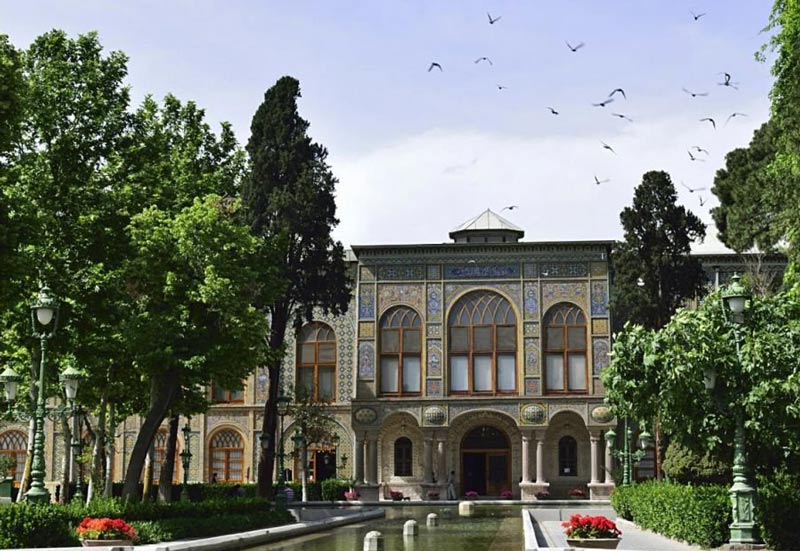
Leisure and Tourism Facilities of Golestan Palace
At the Golestan Palace you can also use the facilities provided for you:
Golestan Palace Teahouse:
If you're tired of visiting the monuments and want to take a break, head to the café; the delectable beverages of this cafe will bring you sweet moments. In this section you can order food as well.
Qajar style photography:
If you want to continue your experience of visiting the Golestan Palace in a different way, go to the photography booth, wear Qajar dresses and take Your unique memento.
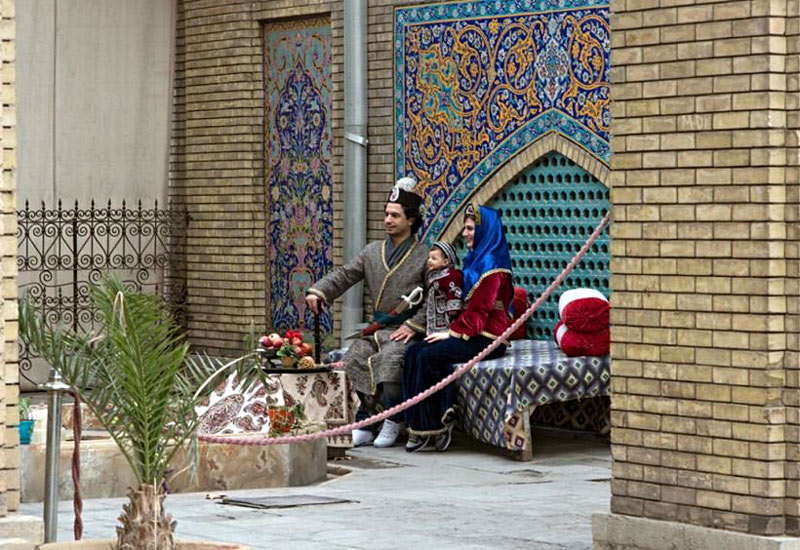
Other Features:
There is also a restroom and praying room for visitors to use.
Side services at Golestan Palace
The Golestan Palace, as a cultural and historical complex, offers other auxiliary services besides providing the opportunity to visit as well:
1. Manuscript library
The establishment of the library and treasures of the manuscript of the Golestan Palace dates back to the early 13th century AH.
Fath Ali Shah Qajar sought to create this treasure and named it the Shahanshahi Library. The Imperial Shahanshahi created a large collection of books by past kings’ libraries such as Safavid and Zandiyeh.
After the death of Muhammad Shah Qajar, during the reign of Nasser Al-Din Shah, the library was renamed the Royal Library and more attention was paid to its expansion.
During the late Qajar monarchy, many books were stolen and taken by the beneficiaries. Some exquisite works have also been donated from the library, including 60 pieces of Hamzeh Nameh's paintings.
This work is one of the masterpieces of calligraphy and painting and is now held at the National Museum of Vienna.
With the formation of the National Library in the Pahlavi era, about 14,000 volumes of books were moved from the Royal Library to the new library, with the rest of the manuscript in stock.
After many ups and downs today, this library has over 3200 manuscripts, the most important of which is Golshan, Shahnameh Baysangari and Thousand and One Nights.

The original is not given to anyone, and in certain cases where parts of the original are required to be verified, it is provided to the library administrator and the administrator give it to people after getting license.
This is done exclusively in the repository with the full supervision of the librarian for a limited time.
It is possible to use digital scans or photographs of stone manuscripts and stone prints for the purpose of introducing a valid letter.
In order to extend the life of the manuscript and the printing of stone and lead and to make it easy to use, scanning and microfilm and digital photography of the manuscript is essential.
Address: Golestan Palace, Management Building, First Floor, Royal Library
2. Image Documentation Center
The Image Documentation Center or Album House is a treasure trove of Qajar kings and albums dedicated to them. The album collection date back to about 1850.
The Golestan Palace Album is one of the richest collections of photographs in the world, featuring black, white, colored and lithographed photographs of travel, ceremonies, images of women, especially the special wives of the Shah.
The home album holds 1520 albums and about 9,000 jars. It is one of the world's most important repositories and the second largest photo and video repository after the British Museum.
Address: Golestan Palace, Management Building, Third Floor, Image Documentation Center
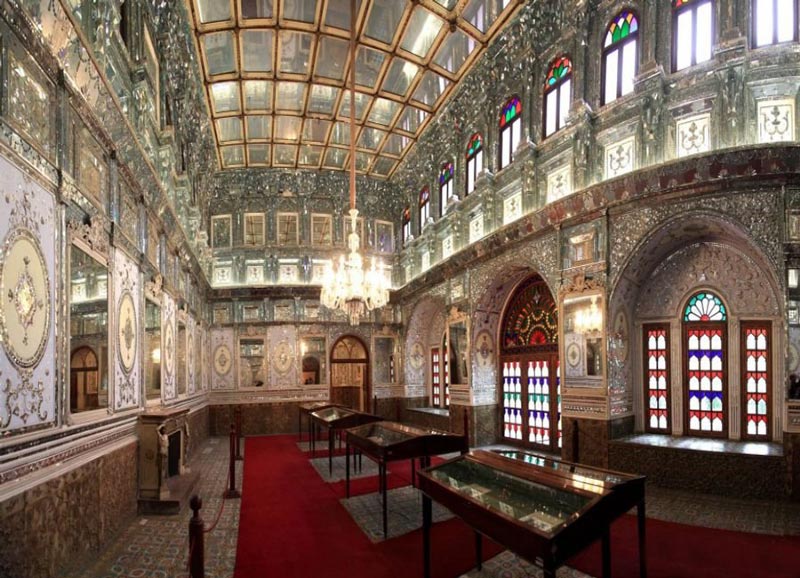
3. Manuscript Documentation Center
The Golestan Palace Documentation Center is one of the largest and most important centers of manuscript documentation in Iran, and is one of the most important centers in the world in terms of the number of Qajar-era manuscript and written documents.
There are over 500,000 documents in this collection:
- Manuscripts with various scientific, astronomical, religious, philosophy and other humanities titles
- Commandments of the kings of the Qajar era
- 19th Century handwritten notes of European classical music by world classical musicians
- Documents on some of the contracts between Iran and other countries in the 19th century
- A collection of envelopes of the Qajar era that are unique regarding their diversity and number in the world.
- A Collection of Government Letters and Correspondence from the Qajar Period to the First Pahlavi Period
This treasure is one of the largest scientific and cultural collections in the country and provides services to researchers and scientists in Iran and the world.
Address: Golestan Palace, Management Building, Second Floor, Manuscript Documentation Center

4. Technical office
Technical office designs, supervises, and controls the architectural and restoration affairs.
Students and scholars of the major of restoration of the constructions, Civil Engineering and Architecture make the most use of this section.
They can obtain documents and information on the material architecture style and other research needs.
Students and researchers must have a letter from the university or other relevant institutions to use the maps, documents and information available.
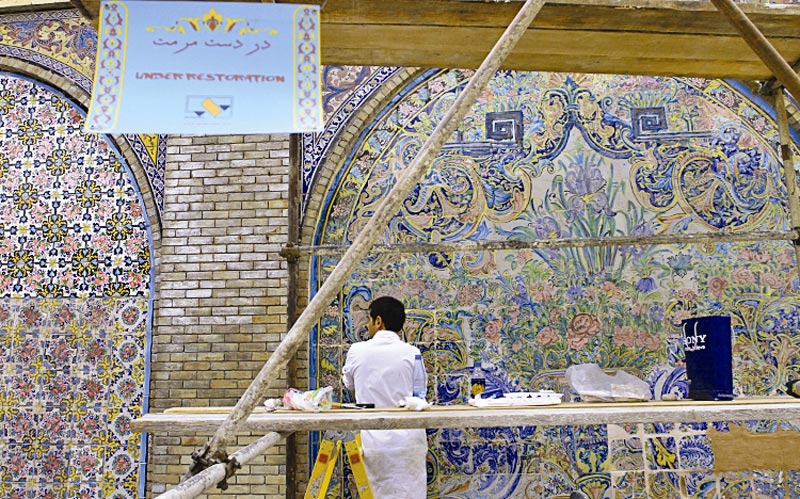
5. Printed library
The Golestan Palace Printing Library was housed in the Anthropological Museum until 2007 and since then has been moved to the second floor of the management building on the northeast side of the garden.
General topics in this collection are:
Historical books (Qajar), artistic, cultural, religious, fiction, articles, theses and various publications along with old and valuable publications such as Vahid, Armaghan, Yadegar, music and art and people.
It is possible to read books freely in the library by submitting a letter.
You can visit this library on Saturdays and Wednesdays from 08:30 to 2:30.
Address: Golestan Palace, Management Building, Second Floor, Printed Library

6. International Affairs
Golestan Palace International Affairs began its work in July 2010 with the aim of introducing the rich historical-artistic works of the palace to the international community.
Among the activities that this department contributes to achieving its predetermined goals are:
organizing international exhibitions, inter-museum activities to the world level, building cultural relationships and adopting a relationship with the world museum in the form of cultural agreements.
The unit serves all foreign researchers in the field of art at the Golestan Palace.
Address: Golestan Palace, Management Building, Third Floor, International Affairs
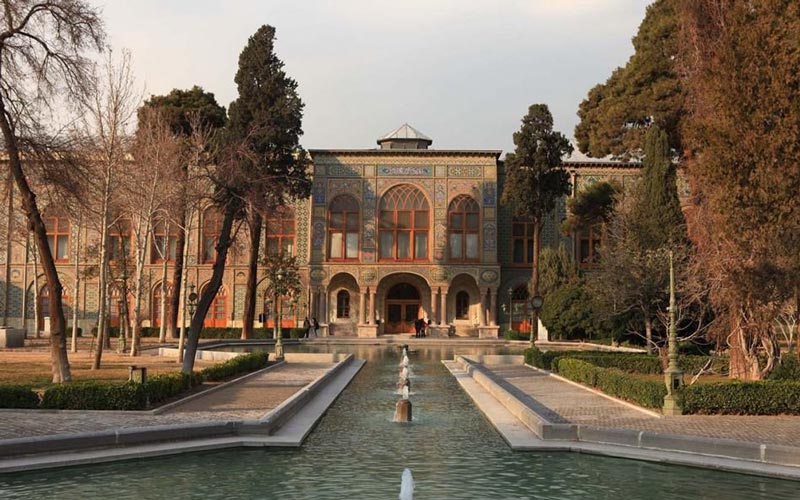
7. Cultural Affairs
The cultural and historical potential of the Golestan Palace has made it an ideal venue for various exhibitions, cultural gatherings and conferences.
In order to better integrate and coordinate this unit since October 2011, the unit has been set up in the Golestan Palace complex, and all coordination in the field of cultural affairs must be done by this unit.
Address: Golestan Palace, Management Building, Third Floor, Office of Cultural Affairs

8. Introduction Affair
Introductory works started in 2012 at Golestan Palace and follow these activities:
- Themes and objectives of the research to introduce the museums and works of the Golestan Palace Collection
- Preparation of identity of the works displayed in the Museum and their subtitles (their correction)
- Preparation of articles by the guides (experts) and holding training sessions to enhance the level of museum knowledge
- Providing brochures for each museum, catalog, Golestan Palace booklet, quarterly journal
- Preparation of museum information plan at the entrance of the collection
- Organizing periodical or seasonal exhibitions and events
Direct contact with all respected visitors of all ages and levels using a questionnaire and hearing their views and suggestions to better introduce and attract more audiences
Address for sending Research Projects: Golestan Palace, Adjacent to Marble Bed, Ground Floor, Audience Attraction Network
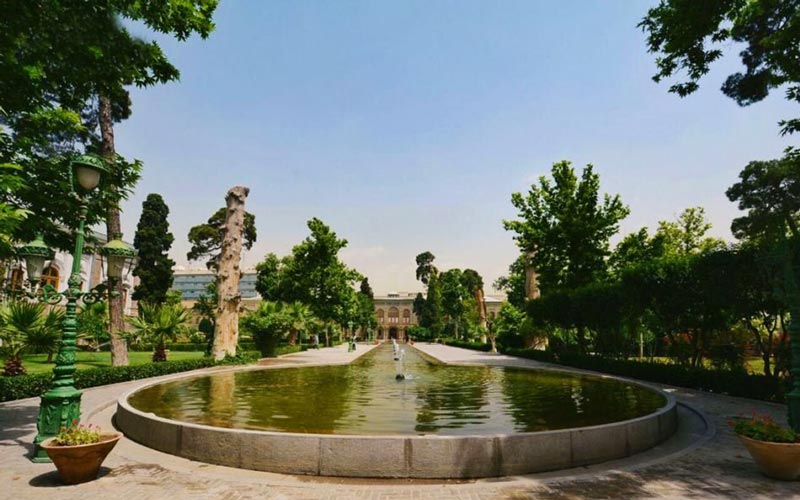
9. Child and adolescent unit
Iran is a young country and has the potential to use its potential children, in pursuit of its goals. In this regard, in April 2011, the Office of Child and Adolescent in Golestan Palace was approved and this unit officially started its activity.
Office activities for children and adolescents include:
- Dedicating one of the second floor anthropology museums to preserve traditional and Iranian dolls and toys, including tents, gigs, tights, dolls of Iranian myths and indigenous dolls.
- Performing puppet shows with the theme of traditional shows
- Implementation of various educational programs on various topics of cultural heritage, spiritual heritage, crafts and etc.
- Holding various exhibitions in the field of children and adolescents, including photos, books or illustrators
- The display of old kid’s movies
- Continuous cooperation with different children's festivals
- Run special events, such as World Children's Day or national and religious occasions
- Collaborate with local and international child-related organizations such as the Intellectual Development Center, the Ministry of Education, UNICEF and etc.
- Promotion of storytelling and reading
- Preparation of appropriate brochures for children and adolescents
- Coordinate targeted museum visits for children, teens, educators and all arts and culture activists for children
Address: Golestan Palace, next to the Museum of Anthropology, Ground Floor, Child and adolescent unit

You can stay at Tehran's Novotel Hotel for accommodation in Tehran as well as visiting the Golestan Palace. If you have not yet booked your hotel, you can use the link below to book Novotel hotel in Tehran.
Access to Golestan Palace
Address: Arg Square, 15 Khordad Ave., District 12, Tehran
Personal car
Streets leading to the Golestan Palace, including Bab Homayoun, Soor Esrafil, Davar and Sabzeh Meydan, are paved and vehicles cannot pass in the area.
So if you are heading to this attraction by private car, you should park your car in the surrounding streets and continue on the path.
Also keep in mind that this part of the city is within the scope of the traffic restriction.
Subway
The best way to get to Golestan Palace is to use the subway. Just reach the 15 Khordad station and take a short walk to the Golestan Palace in front of you.
Bus
If you plan to take the bus, use the lines that cross Khayyam Street and stop at Galubandak Station.
Taxi
There are numerous taxis from around the city that take you to Galubandak intersection, a few steps from Golestan Palace. These taxis can be found in places such as Sadeghiyeh, Fatemi Square, Enghelab Square, Jomhoori Street, Razi Square and more.

Visiting information
Visits: Every day except June 14th, the day of Imam Khomeini's death, 21st Ramadan coincided with the martyrdom of Imam Ali (AS), Tasoa and Ashura Hosseini, 28 Safar coincides with the martyrdom of Imam Hassan Mojtaba (AS), 25th of Shaval which is the martyrdom of Imam Sadeq (AS)
Visiting Hours: 9am to 6pm in the first six months of the year and 9am to 5pm in the second six months of the year
Visiting Hours in Ramadan: 09:30 to 5:30 and ticket sales until 4:30
Note: It takes about two hours to visit the complex so don't postpone your visit to the closing hours.
Important notes when visiting the Golestan Palace
Photography is permitted in Shams Al-Emareh museums, wind catchers, photography and anthropology museums without the use of flash and tripods.
Photography and filming are allowed on the Golestan Palace grounds without a tripod.
Professional photography with tripods and accessories is prohibited unless prior coordination is achieved.
Photographing in the museums of the courtyard, gallery, special and main hall is prohibited by any means.
Visitors should contact the public relations office for a visit to the museum before visiting the collection.
Visitors can only buy one ticket and visit one museum, but entry ticket is required.
Make your visit on the designated routes.
Do not leave your children's hands unattended during the visit. Failure to control them can result in your children being exposed to the art works and thus harming them.
Keep a good distance from the glass and base shields so that they do not fall over.
Don't touch the works at all. It transfers bacteria, moisture, perspiration and ... of your hands to the work, and eventually leads to the creation of some harmful compounds on their surface and ultimately their destruction.
Do not use a flash when photographing museum artifacts. The flash has damaging rays and over time it has a bad effect on various works like paintings, woven, colored paints and so on.
Do not use monopods when photographing, especially inside museums, as they increase the likelihood of hitting the objects.
Professional photography with accessories such as tripods, etc. is prohibited in the courtyard and inside the museums unless licensed.
Promotional photography is prohibited without obtaining the necessary permits in and around the museums.
A stop on the way to take photos will cause a crowd. Do not do this for security reasons.
Don't take your food to museums.
Avoid throwing garbage in museums and green spaces.
Baby Stroller are not allowed in museums.
If you see any damage to the museum's buildings and museum artifacts, please let the collection office know about it.
Get help from museum guides if you have any questions.
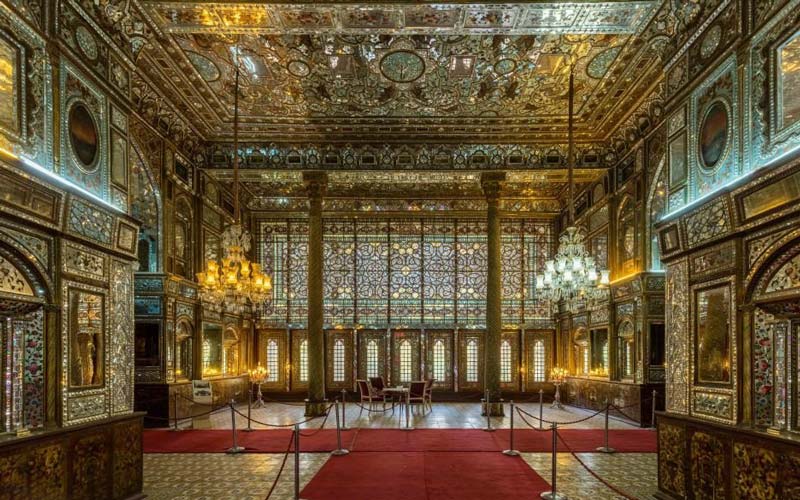
National and World Registration
Golestan Palace Complex is an invaluable and unique legacy that has been on Iran's National List since February 1st, 1956.
This remarkable work is also one of Iran's honors on the UNESCO World Heritage List.
The Golestan Palace file was sent to UNESCO in 2007, and after a long review of bug fixes, it succeeded on June 4, 2013 in the annual UNESCO World Heritage Session to be registered as the 16th Iranian monument in the world.
The following criteria have been put forward to record this work:
- A masterpiece of human ingenuity and creativity.
- Shows the exchange of human values over a period of time that have occurred in a cultural area and have been a manifestation of advances in architecture or technology, urban planning or landscape design.
- A unique or at least exceptional document about a cultural tradition or civilization alive or gone.
It is a prominent example of architecture or technology that represents an important stage in human history.
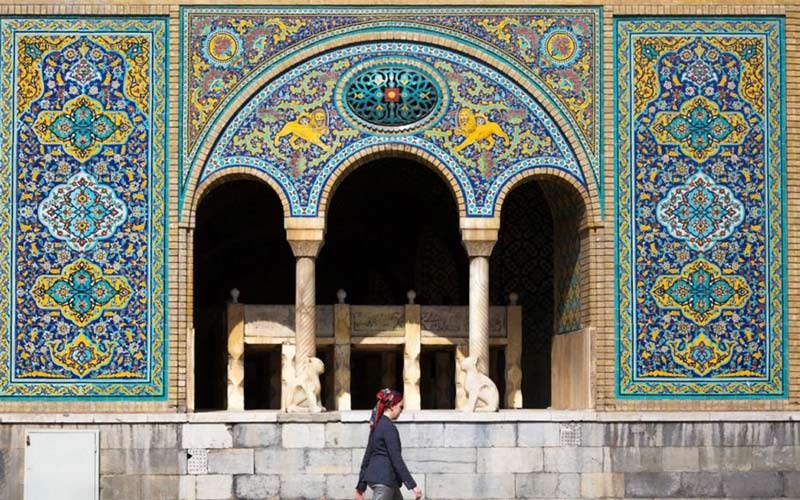
Tourists comments on Golestan Palace
Golestan Palace Complex is one of Tehran's most fascinating sights and attractions of Iran, so many foreign tourists visit it.
Here we want to know what these tourists think about this work. Take a look at their views on the TripAdvisor website:
English Tourist - June 1977
A place to watch the magnificence of Persia
You can see numerous palaces in a relatively large courtyard. Interior decoration using mirrors is spectacular. The first thing that caught my attention in this work was the manifestation of Iranian art.
French Tourist - June 1977
Frustrating!
It was a good place to start a trip to Iran, but there are better and more beautiful places in the country, so seeing this place is not good enough. You can spend a short time there.
Tourist from Australia - June 1977
Eye-catching mirrorwork in the main hall
This was the first attraction we saw in Tehran, which illustrated the importance of mirrors in Iranian culture. The buildings were in the middle of a blooming garden, but the trees were a little messy, and that created an unpleasant sight.
The entrance fee is relatively expensive and you will have to pay a separate fee to visit each building. At this time, you have to choose. In my opinion, the main hall is worth seeing.

Dutch Tourist - June 1977
A must see!
Buy entrance tickets for all buildings. Don't be stingy and pay a little money because there are so many historic and beautiful things to see. The courtyard is great and even the replicas look good in this building.
I recommend eating out of the palace because the restaurant inside it is very expensive and extremely slow.
Malaysian Tourist - June 1977
extraordinary!
The architecture of this place is great and the mosaics, glass and mirrors are beautifully applied. The furniture and antiques are unique and beautiful.
Conclusions for Tourism Guide at Golestan Palace
Touring Tehran is one of the attractive options for foreign travelers to Tehran. If you want to go to a beautiful and quiet place, without leaving the city, be sure to include a visit to the Golestan Palace in your plan.
This collection keeps the best memories in your mind and provides a memorable journey in history. If you are visiting this palace, share your experience with us and your friends at the Hoteloneclick.
We look forward to your comments; you can also click on the comments section below to share your photos of this palace at Hoteloneclick.
If you have any comments about Golestan Palace in Tehran which are not mentioned in this article, you can write in the comments section of this guide.
If you find this guide helpful, we'll be happy if you share it on social networks.
